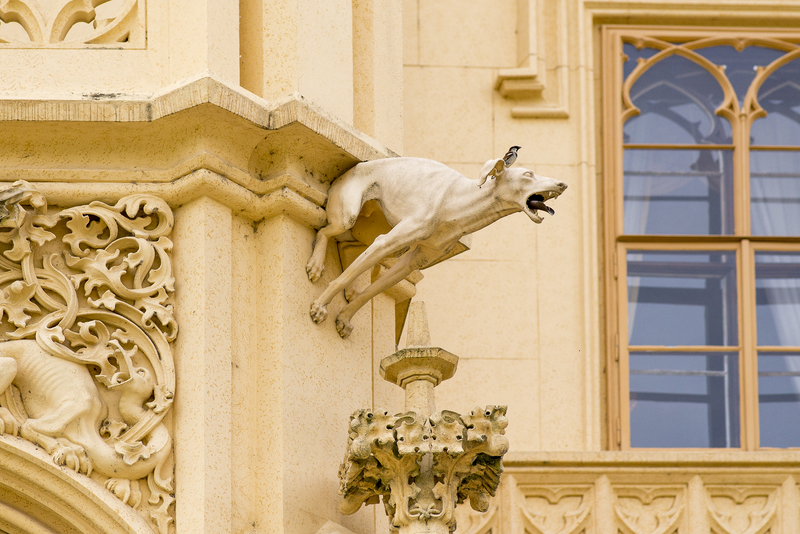
One of the more fairytale-like castles in Europe can be found in South Moravia, the Czech Republic. Lednice Castle was  originally built in the 13th century and was the property of the Liechtensteins, one of the wealthiest families in Moravia. It was torn down in the 17th century and replaced with a Baroque palace, and rebuilt yet again in the 19th century in a Neo-Gothic style which remains today. The castle suffered during the second World War under communistic nationalization, but it is still something worthy of a visit, and in fact, is a popular tourist destination. Gargoyles are a prominent aspect of the castle, and they appear in shape of monsters, dragons and yes, dogs. The sighthound gargoyle seen here is likely a “rain gargoyle,” the dog’s mouth doubling as a spout designed to carry water from a roof and the side of a building.
originally built in the 13th century and was the property of the Liechtensteins, one of the wealthiest families in Moravia. It was torn down in the 17th century and replaced with a Baroque palace, and rebuilt yet again in the 19th century in a Neo-Gothic style which remains today. The castle suffered during the second World War under communistic nationalization, but it is still something worthy of a visit, and in fact, is a popular tourist destination. Gargoyles are a prominent aspect of the castle, and they appear in shape of monsters, dragons and yes, dogs. The sighthound gargoyle seen here is likely a “rain gargoyle,” the dog’s mouth doubling as a spout designed to carry water from a roof and the side of a building.
If the castle and the hound gargoyle seem familiar, it’s because they were featured in the 2006 remake of “The Omen.”
As an aside, while ancient Egyptians, Greeks, Etruscans and Romans all used animal-shaped waterspouts, gargoyles helped communicate ideas to a largely illiterate population in Medieval Europe, and dogs were the most common animal crafted as a gargoyle. They were seen as faithful, loyal, and intelligent, and excellent guardians (like, say, the building on which they sat). They weren’t perfect, however, and were known for nipping food off an unwatched kitchen table. For this reason, dog gargoyles were often perched on the sides of cathedrals to show that even a faithful animal like the dog can fall prey to the temptation of the devil and commit the sin of greed.
Top image by © Vladiczech | Dreamstime
